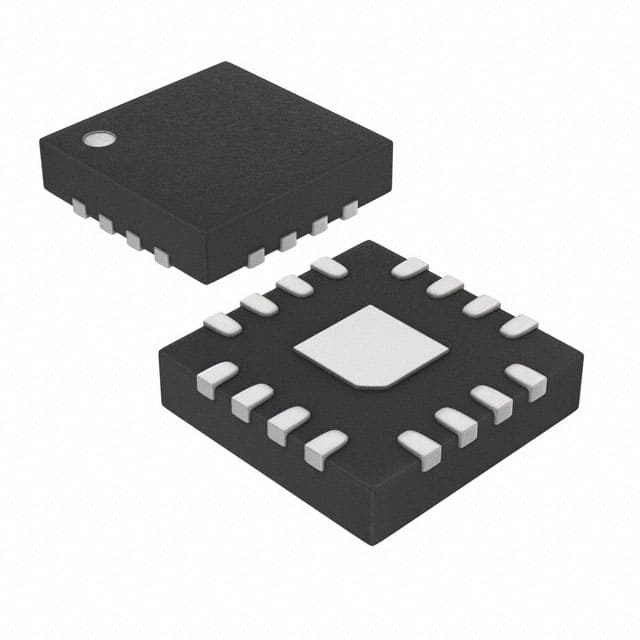Lihat spesifikasi untuk detail produk.

MAX4815ETE+ - English Editing Encyclopedia Entry
Product Overview
Category
The MAX4815ETE+ belongs to the category of integrated circuits (ICs).
Use
This IC is commonly used for communication purposes, specifically in applications involving RS-485/RS-422 transceivers.
Characteristics
- The MAX4815ETE+ is a low-power transceiver that supports data rates up to 2.5Mbps.
- It operates with a single 3.3V power supply.
- This IC features a half-duplex configuration, allowing bidirectional communication on a single pair of wires.
- It offers a wide common-mode voltage range, making it suitable for use in noisy industrial environments.
Package and Quantity
The MAX4815ETE+ is available in a small-sized TQFN package, which stands for Thin Quad Flat No-Lead. The package dimensions are 4mm x 4mm. It is sold in reels or tubes, with a typical quantity of 2500 units per reel.
Specifications
- Supply Voltage: 3.3V
- Data Rate: Up to 2.5Mbps
- Operating Temperature Range: -40°C to +85°C
- Number of Pins: 16
- Package Type: TQFN
Pin Configuration
The MAX4815ETE+ has a total of 16 pins. Below is the detailed pin configuration:
- DE - Driver Output Enable
- RE - Receiver Output Enable
- RO - Receiver Output
- DI - Driver Input
- GND - Ground
- A - Non-Inverting Driver Input
- B - Inverting Driver Input
- VCC - Power Supply
- Y - Non-Inverting Receiver Output
- Z - Inverting Receiver Output
- NC - No Connection
- NC - No Connection
- NC - No Connection
- NC - No Connection
- NC - No Connection
- NC - No Connection
Functional Features
- The MAX4815ETE+ provides a high level of ESD protection, safeguarding the IC from electrostatic discharge.
- It features a fail-safe receiver, ensuring that the receiver output is in a known state when the inputs are unconnected or shorted.
- This transceiver supports a wide range of common-mode voltages, allowing reliable communication in noisy environments.
- It has a low quiescent current, making it suitable for battery-powered applications.
Advantages and Disadvantages
Advantages
- Low-power consumption
- Wide common-mode voltage range
- High ESD protection
- Fail-safe receiver
Disadvantages
- Limited data rate (up to 2.5Mbps)
- Half-duplex configuration only
Working Principles
The MAX4815ETE+ operates based on the RS-485/RS-422 standards. It uses differential signaling to transmit and receive data over long distances. The driver section converts the logic-level signals into differential voltages, while the receiver section converts the differential voltages back into logic-level signals. The half-duplex configuration allows bidirectional communication on a single pair of wires by enabling either the driver or receiver at a time.
Detailed Application Field Plans
The MAX4815ETE+ finds applications in various fields, including:
- Industrial Automation: It is used for communication between PLCs (Programmable Logic Controllers), sensors, and actuators in industrial automation systems.
- Building Automation: It enables communication between different building control systems, such as HVAC (Heating, Ventilation, and Air Conditioning) systems, lighting control, and security systems.
- Instrumentation: It is utilized in data acquisition systems, allowing reliable transmission of sensor data over long distances.
- Automotive: It is employed in automotive applications for communication between various electronic control units (ECUs) within the vehicle.
Detailed and Complete Alternative Models
- MAX4816ETE+: Similar to MAX4815ETE+, but with a higher data rate of 20Mbps.
- MAX485EESA+: A compatible alternative with a lower supply voltage range of 4.75V to 5.25V.
- SN65HVD485EDR: Another RS-485 transceiver option with a wide supply voltage range and enhanced ESD protection.
In conclusion, the MAX4815ETE+ is a low-power RS-485/RS-422 transceiver IC that offers a wide common-mode voltage range and high ESD protection. It is commonly used in industrial automation, building automation, instrumentation, and automotive applications. While it has limitations in terms of data rate and half-duplex configuration, there are alternative models available with different specifications to suit specific requirements.
Sebutkan 10 pertanyaan dan jawaban umum terkait penerapan MAX4815ETE+ dalam solusi teknis
Sure! Here are 10 common questions and answers related to the application of MAX4815ETE+ in technical solutions:
Q: What is the MAX4815ETE+? A: The MAX4815ETE+ is a low-power, high-speed RS-485/RS-422 transceiver.
Q: What is the operating voltage range of MAX4815ETE+? A: The operating voltage range of MAX4815ETE+ is from 3V to 5.5V.
Q: Can I use MAX4815ETE+ for half-duplex communication? A: Yes, MAX4815ETE+ supports both half-duplex and full-duplex communication.
Q: What is the maximum data rate supported by MAX4815ETE+? A: MAX4815ETE+ supports data rates up to 20Mbps.
Q: Is MAX4815ETE+ compatible with standard RS-485 and RS-422 protocols? A: Yes, MAX4815ETE+ is fully compatible with both RS-485 and RS-422 protocols.
Q: Can I connect multiple MAX4815ETE+ devices on the same bus? A: Yes, you can connect multiple MAX4815ETE+ devices on the same bus using the RS-485 protocol.
Q: Does MAX4815ETE+ have built-in protection features? A: Yes, MAX4815ETE+ has built-in protection features like short-circuit and thermal shutdown protection.
Q: Can I use MAX4815ETE+ in industrial environments? A: Yes, MAX4815ETE+ is designed to operate reliably in harsh industrial environments.
Q: Does MAX4815ETE+ require external termination resistors? A: Yes, for proper operation, external termination resistors are required at the ends of the bus.
Q: What is the package type of MAX4815ETE+? A: MAX4815ETE+ is available in a 16-pin TQFN package.
Please note that these answers are general and may vary depending on specific application requirements. It's always recommended to refer to the datasheet and consult with technical experts for detailed information.

